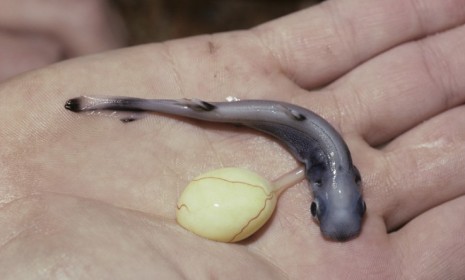The tiny shark that glows in the dark
Scientists have long been fascinated by the bioluminescent undersides of the hand-sized pygmy shark, and now they've confirmed the creature's secret

The shark is already the ocean's most feared predator. But two lesser-known (and relatively unintimidating) tiny species of the hunter have an extra "superpower," says Jeanna Bryner at LiveScience. The hand-sized smalleye pygmy shark and its slightly larger relative, the lantern shark, possess the astounding ability to make their bellies glow. And now, new research published in the Journal of Experimental Biology confirms why the animals evolved the trick. Here's a glimpse at the ocean's tiny, glow-in-the-dark predators:
Why do they glow?
It's long been speculated that these relatively vulnerable sharks use their ability to glow primarily as a camouflage strategy and the new study, conducted by biologists from the Catholic University of Louvain in Belgium, tested that theory. Whenever these small sharks swim close to the surface, they put themselves at risk of being spotted by larger predators below them. The glowing bellies are a form of "counter-illumination," says BBC News. "Without it, anything looking upwards for a meal would easily see the sharks' bodies silhouetted against the bright sky above."
The Week
Escape your echo chamber. Get the facts behind the news, plus analysis from multiple perspectives.

Sign up for The Week's Free Newsletters
From our morning news briefing to a weekly Good News Newsletter, get the best of The Week delivered directly to your inbox.
From our morning news briefing to a weekly Good News Newsletter, get the best of The Week delivered directly to your inbox.
How do they glow?
Both species have photophores dotting their undersides, which use different hormone triggers to emit a blue glow.
What did researchers do?
The team captured a few hand-sized pygmies off the coasts of Taiwan. Researchers scraped off samples of the creature's glowing skin, and injected a number of substances (such as neurotransmitters and hormones) to see what triggered the biological glow. As with lantern sharks, the hormone melatonin made the smalleye pygmy shark's skin glow continuously. But another hormone called prolactin — which makes lantern sharks light up in 30-minute flashes — had a surprise effect on the pygmies: The glow dimmed instead.
A free daily email with the biggest news stories of the day – and the best features from TheWeek.com
What does that mean?
The pygmy only has one type of glow (spurred by melatonin), which is only used for camouflage. The lantern shark, on the other hand, has more control over its ability to glow and can use consistent light for camouflage or intermittent flashes (spurred by prolactin) to communicate. This distinction is important, says researchers, because it means the lantern shark is unique.
Sources: BBC News, LiveScience, Red Orbit, PhysOrg
-
 The biggest astronomy stories of 2025
The biggest astronomy stories of 2025In the spotlight From moons, to comets, to pop stars in orbit
-
 The 8 best comedy movies of 2025
The 8 best comedy movies of 2025the week recommends Filmmakers find laughs in both familiar set-ups and hopeless places
-
 ‘Care fractures after birth’
‘Care fractures after birth’instant opinion Opinion, comment and editorials of the day